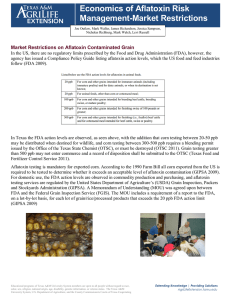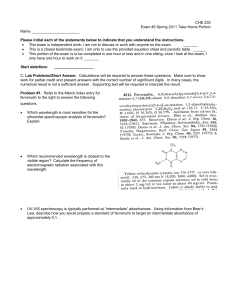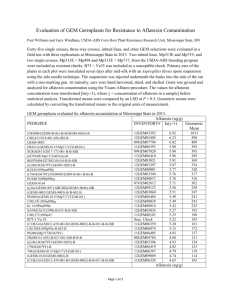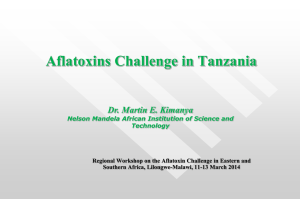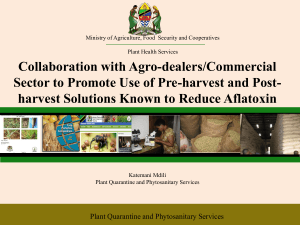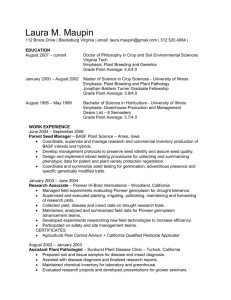Economics of Aflatoxin Risk Management-Market Restrictions
advertisement
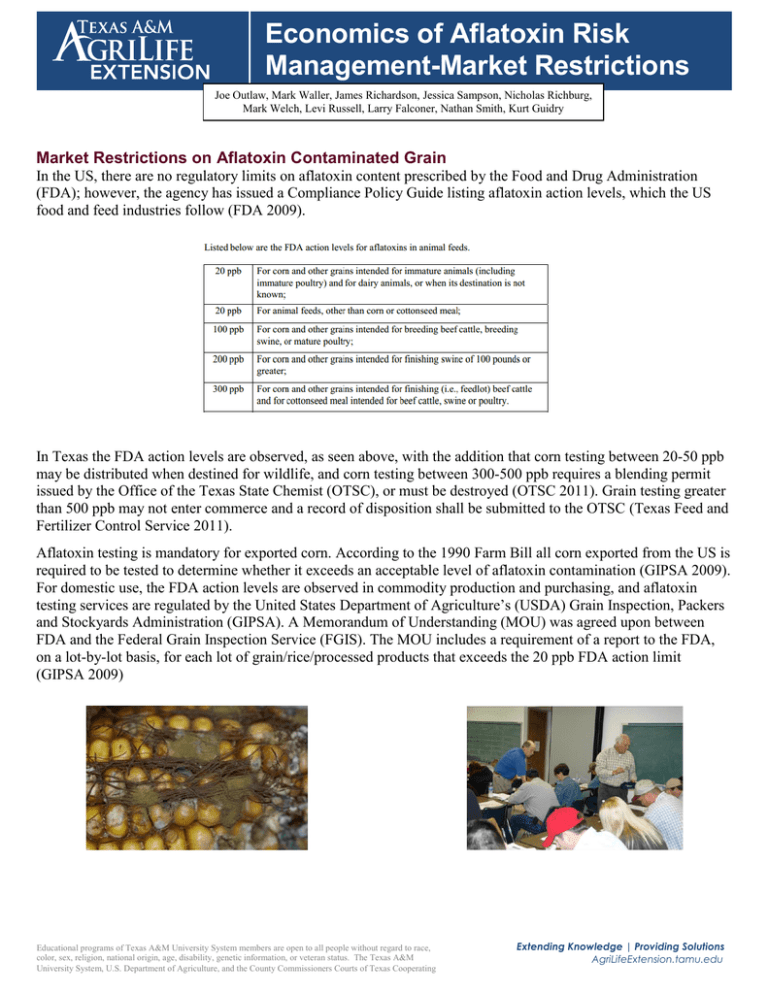
Economics of Aflatoxin Risk Management-Market Restrictions Joe Outlaw, Mark Waller, James Richardson, Jessica Sampson, Nicholas Richburg, Mark Welch, Levi Russell, Larry Falconer, Nathan Smith, Kurt Guidry Market Restrictions on Aflatoxin Contaminated Grain In the US, there are no regulatory limits on aflatoxin content prescribed by the Food and Drug Administration (FDA); however, the agency has issued a Compliance Policy Guide listing aflatoxin action levels, which the US food and feed industries follow (FDA 2009). In Texas the FDA action levels are observed, as seen above, with the addition that corn testing between 20-50 ppb may be distributed when destined for wildlife, and corn testing between 300-500 ppb requires a blending permit issued by the Office of the Texas State Chemist (OTSC), or must be destroyed (OTSC 2011). Grain testing greater than 500 ppb may not enter commerce and a record of disposition shall be submitted to the OTSC (Texas Feed and Fertilizer Control Service 2011). Aflatoxin testing is mandatory for exported corn. According to the 1990 Farm Bill all corn exported from the US is required to be tested to determine whether it exceeds an acceptable level of aflatoxin contamination (GIPSA 2009). For domestic use, the FDA action levels are observed in commodity production and purchasing, and aflatoxin testing services are regulated by the United States Department of Agriculture’s (USDA) Grain Inspection, Packers and Stockyards Administration (GIPSA). A Memorandum of Understanding (MOU) was agreed upon between FDA and the Federal Grain Inspection Service (FGIS). The MOU includes a requirement of a report to the FDA, on a lot-by-lot basis, for each lot of grain/rice/processed products that exceeds the 20 ppb FDA action limit (GIPSA 2009) Educational programs of Texas A&M University System members are open to all people without regard to race, color, sex, religion, national origin, age, disability, genetic information, or veteran status. The Texas A&M University System, U.S. Department of Agriculture, and the County Commissioners Courts of Texas Cooperating Extending Knowledge | Providing Solutions AgriLifeExtension.tamu.edu Aflatoxin Test Variability Aflatoxin contamination test variability is a source of risk to the buyer and the seller because contamination is randomly distributed throughout the load (i.e. truckload or bin). The implications this creates are potentially detrimental to the buyer and seller. The sporadic contamination presents two unfavorable and inaccurate test result possibilities; a false positive or a false negative. If a false positive occurs, the lot of corn has tested higher for overall aflatoxin contamination than it actually has. If a false negative occurs, the lot of corn has tested lower for overall aflatoxin contamination than it actually has. The possibility of inaccurate test results is also a source of risk with regard to reconciliation between any discounted value at the local grain elevator and crop insurance indemnity payments. The market discount is determined by the local elevator aflatoxin test. The calculation for crop insurance indemnities is based on a separate test completed by an approved third party testing facility. The local elevator tests and pays based on truckloads of corn, and crop insurance tests and pays indemnities based on insured fields. An insurance adjustor is either sent out to the insured field to gather corn samples for an aflatoxin test pre-harvest or some corn is left standing postharvest for them to sample from. Or, the local elevator purchasing corn will save samples from all tested loads, and the insurance adjustor will obtain these samples for the appropriate field or fields, combine the samples by field, and remove a subsample to test for aflatoxin contamination. The testing variability has the potential to discount producers at the local market price for aflatoxin contamination. The insurance test could then result in a less severe aflatoxin contamination level and this could fail to trigger an indemnity payment for an already discounted market sale. One Sample Strategy One method available to avoid the discrepancy in test results is the One Sample Strategy. The One Sample Strategy is a training and certification process, for Texas grain elevators, that allows aflatoxin tests done at certified local elevators to be the same test results used in crop insurance calculations (OTSC 2013c). The ability to use one test for both outlets decreases the possible variation between two separate tests, but does not affect the issue of false positives or false negatives. References FDA. 2009. Action levels for aflatoxin in animal feeds. CPG Sec 683.100 Grain Inspection Service (GIPSA). 2009. Aflatoxin Handbook. Office of the Texas State Chemist (OTSC). 2013c. One Sample Strategy. Available from http://otscweb.tamu.edu/Risk/OneSample/Default.aspx;. Texas Feed and Fertilizer Control Service. 2011. Commercial Feed Rules, Public Law Chapter 61, Texas Administrative Code, Title 4 Agriculture Partial funding for this project was provided by:
